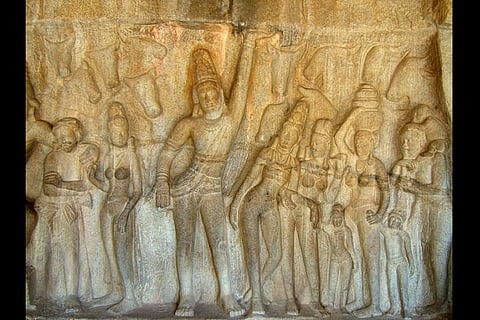

Lord Krishna is benign and yet powerful at the same time. He is flirting around with Gopikas on the one hand, and reveals profound philosophy through the Bhagawad Gita on the other. Down to earth, almost human-like in his day-to-day affairs and yet divine in his qualities, Krishna is a god that one can relate to.
Though mythology situates him in North India, Krishna worship and cult following has been in vogue across south India for centuries. In fact, some of the customs have remained undiluted for centuries unlike in the north. Some of the finest temples in the South are dedicated to Krishna. The Mahabharata and Shrimad Bhagawatam are full of stories, episodes, plots and adventures that take place south of the Vindhyas. Several researchers and academics have strongly argued and even proved that Shrimad Bhagawatam might have been written in the Tamil speaking regions of South India. Ancient temple sculptures depicting various episodes from the life of Krishna are common all over Tamil Nadu, Andhra and Karnataka. It is impossible to miss the 7th century cave temple created by the sculptors of the Pallava kingdom in Mahabalipuram. Here you see a larger than life Krishna carrying the Govardhana hill, all carved out of a single rock!
Carnatic classical music and dance cannot be too far behind. Let us look at some of the best literature in classical music and dance dedicated to Krishna. An ideal Carnatic Kacheri or a concert begins with a Varnam. A fast-paced track is also to ready the singer, warm up his or her vocal chords for the rest of the performance. There have been several Varnams written in praise of Krishna. But nothing comes close to ‘Viriboni’, a Varnam in Ragam Bhairavi written by composer Pachchimiriam Aadiappaiah, about whom there isn’t much biographical detail available. He wrote this in praise of Krishna who is worshipped as Rajagopala in the ancient temple of Mannargudi in Thanjavur district. The one person who mastered this rather difficult Varnam and sang it with ease was the one and only M S Subbulakshmi. Listen to her voice here:
In Kuchipudi, the dance-drama form of Andhra Pradesh, the magnum opus of the 14th century poet Siddhendra Yogi is the operatic piece popular as ‘Bhama Kalapam’. The poem narrates the episode of Satyabhama, the consort of Krishna desiring the Parijatam tree. Not too far from the village of Kuchipudi is the village of Muvva where Krishna is worshipped as Gopala. The famous poet Kshetrayya (1600-1680) wrote hundreds of erotic poems to Krishna. Most of these were performed in dance by the temple dancers of the region. The Kuchipudi dance-drama format underwent a metamorphosis with guidance from Gurus like Vempati Chinna Satyam. The ‘Sabdam’ usually performed in the first half of a dance recital is everyone’s favourite. The ever-popular ‘Krishna Sabdam’ narrates tales from the life of Krishna and his romantic dalliances with Gopikas. Watch the wonderful Manju Bharghavi of Shankarabharanam fame perform the same here.
The Vijayanagara rulers were great patrons of art and artistes. Several famous temples were constructed during their reign in what is now modern Karnataka. ‘Sangita Pitamaha’ of Carnatic music Purandara Dasa (1484-1564) along with the rest of the Dasa Sampradaya saints wrote almost all their poems and songs in love of Krishna. Living and working in Karnataka, some of the greatest poems on Krishna have been written by these saints in Kannada and Sanskrit. Karnataka is also the only state that can claim to be a proud home to Hindustani classical musical tradition. No single geographical location in the North can claim the same with Carnatic music though! The Dharwad belt is filled with some of the finest musicians of all times. Listen to this wonderful composition of poet saint Vadiraja Theertha (1480-1600) by Pt Venkatesh Kumar :
In that series of Dasa Sampradaya comes poet saint Vyasa Teertha (1460 -1539). He wrote the famous song ‘Krishna Nee Begane Baaro’ as an ode to the charming Krishna worshipped in the Udupi temple. The temple itself is grand and ancient. It houses one of the largest temple kitchens that feed thousands of visiting devotees on a daily basis. Vyasa Teertha’s immortal song gained more popularity in the 20th century when Thanjavur Balasaraswati began singing and dancing it. She was the greatest exponent of Bharatanatyam. When Satyajit Ray was asked to make a documentary on her life and art, this particular song was shot on the beach in Mahabalipuram. The history of the shooting itself is long and interesting. But in this short clipping from the same documentary, you can imagine what it would have been to see her perform in a regular concert space.
Where does Krishna really belong? As per mythology, he might have been a Yadava born in North India. But history is witness to him being worshipped, across South as well. As Gopala or the cowherd in Muvva in Andhra, as Rajagopala in Mannargudi, as Guruvayurappa in Kerala and Muddu Krishna in Udupi, he continues to enjoy the love and admiration of his devotees. If you had Meera Bai, Surdas and other saints in the North, you also had Lila Suka, Narayana Theertha, Kanakadasa, Oothukadu Venkata Kavi and many more in the south whose writings got immortalized because of their Bhakti for Krishna. As yet another Krishna Janmashtami is being celebrated across the country, you can immerse yourself in Krishna Bhakti and enjoy the music and dance without any speculation about where he hailed from.
Image Courtesy: Krishnamurthy)